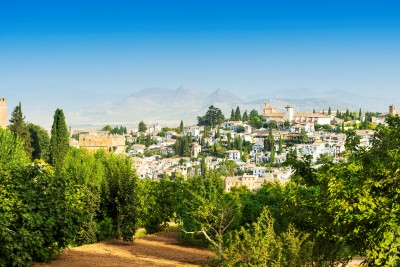Spain's Alhambra in Granada mesmerizes. This Moorish fortress-fantasy palace complex of shady patios, intricate tiles, gurgling waters meandering and splashing everywhere, and its ornate stucco, plaster and woodwork were made an art form here. The best preserved medieval Muslim fortress-palace in the world built during the reign of the Moors between the 8th and 15th centuries, the Alhambra was completed by the Nasrid Dynasty kings in the 14th century.
The interlinked complex is a testament to Moorish craftsmanship, culture and architecture, integrating light, space, water and natural surroundings with simple yet ornate structures and gardens. The oldest part of the complex, the Alcazaba, or citadel, was built in an ideal defensive position on a precipitous plateau flanked by a river and looking towards the towering Sierra Nevada. With its myriad of towers and zigzagging passages, it offers many vantage points. From the Torre de la Vela, the highest tower, spectacular views of the city and the surrounding countryside unfold.
The jewel of the Alhambra, the refined Nasrid Palace, a network of several connected palaces, boasts elaborate Arabic calligraphy and ornate mosaics which grace the stucco walls. Intricately patterned halls and rooms lead to courtyards filled with gleaming reflecting pools and greenery. Passing first through the Mexuar, the public reception hall where the administration of justice was carried out, you reach the Cuarto de Comares, the official residence of the sultan, and the Cuarto de los Leones, the intimate royal apartments which housed the sultan's family, harem and servants. Stunning internal courtyards border the palaces. The Court of the Myrtles, with its lustrous tiles, its arches of beautiful, latticed fretwork and its mirror-like pool reflecting everything in its waters, adorns the Cuarto de Comares. The Court of the Lions, with its 12 stone lions spurting water and filling the central fountain, was the playground for the women. In the adjacent Hall of the Abencerrajas, intricate, exquisite plaster stalactites, hanging from the ceiling, are reflected in a pool, and nearby halls display once- stylish dressing rooms, lavish baths and decorative balconies.
Adjacent to the palace, the Generalife, the recreational park of the Nasrid kings and one of Spain's finest gardens, captivates you with its lily ponds, rose terraces, shady cypress trees and its gently spraying waters.
Though less elaborate than the Narid Palace, the controversial Palace of Charles V, built after the Christian "reconquest" by the eponymous king, is nevertheless grandiose with its unique circle within a square design.
A nighttime visit to the Alhambra, with its fortress and its fantasy palaces is enchanting. A long, beautifully illuminated cobblestone path, lined with large cypress trees, opens to the pools and gardens and offers a glimpse of the stunning sights ahead. Scents of jasmine and orange fill the air to evoke the magical feel of the palace, with its peaceful, spellbinding atmosphere. And high above, the towers of the Alcazaba unveil stunning vistas of the Albaican, the old Moorish quarter of Granada, with its narrow, stone paths, steep hills and whitewashed homes, and its lively restaurants. Granada's Alhambra, in all its enchantment and splendor, floats you far, far away from the 21st century.






